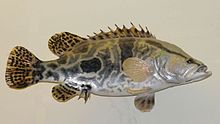Siniperca chuatsi
| Mandarin fish | |
|---|---|

| |
| Scientific classification | |
| Domain: | Eukaryota |
| Kingdom: | Animalia |
| Phylum: | Chordata |
| Class: | Actinopterygii |
| Order: | Perciformes |
| Family: | Sinipercidae |
| Genus: | Siniperca |
| Species: | S. chuatsi
|
| Binomial name | |
| Siniperca chuatsi (Basilewsky, 1855)
| |
| Synonyms[1] | |
| |
Siniperca chuatsi, the mandarin fish (Chinese: 鱖魚,[2]), is a species of freshwater ray-finned fish from the family Sinipercidae, the Oriental perches. It is the type species of the genus Siniperca (Chinese perches).
Description
[edit]Siniperca chautsi has a body which is compressed with a protruding lower jaw and the maxilla reaching behind the eyes. The jaws are armed with rows of saw-like teeth. Lower jaw with 4–5 large sharp rays. There are two flat, sharp spines on the posterior margin of the operculum. It has small, round scales. It has a shiny brownish-yellow body marked with randomly situated coloured blotches and spots. They usually have black or dark grey stripes which run from their lips and run through the eyes over the lateral line but do not reach the back. It has a dorsal fin with the front part containing many hard spines with the rearmost having rounded tips. They have rounded pectoral, anal and caudal fins. There are three sharp spines situated in front of both pelvic and anal fins.[3] The maximum recorded total length of 70 centimetres (28 in) and a maximum published weight of 8 kilograms (18 lb).[1]
Distribution
[edit]Sinipercua cuatsi is found in lowland freshwater habitats throughout continental East Asia excluding the Korean Peninsula, from the drainage basin of the Amur River in Russian Far East/Northeast China to the Pearl River in South China.[1][4][5]
Habitat and biology
[edit]Siniperca chuatsi are found in rivers which have dense growths of aquatic vegetation and water which can be quite turbid in the rainy season. They are demersal piscivores, stalking the fry of other fish species using their acute vision to track their prey before pouncing on them and enveloping them in their large mouth. The species of fish it mostly preys on are diurnal and have good colour vision and high visual acuity in daylight but which have poor night vision.[1] Although it can live in near-freezing water, it only starts feeding when the temperature rises above 15 °C (59 °F) and breeding when it rises above 21 °C (70 °F).[3]
Utilisation
[edit]Siniperca chuatsi is both a popular game fish among anglers and a commercially important species in China, as it is a popular food fish and has been widely farmed in its native range since the 20th century. It first gained major popularity during the Tang dynasty (618–907 A.D.), appearing in many Chinese books and poems.[3] The farmed fish are typically purebred, but sometimes hybrids between this species and its close relative the golden mandarin fish (S. scherzeri).[6] The famed Jiangsu dish of squirrel fish is typically prepared with mandarin fish.
Species description and etymology
[edit]Siniperca chuatsi was first formally described as Perca chuatsi in 1855[7] by the Russian ichthyologist, missionary and physician Stepan Ivanovich Basilewsky (died c. 1867)[8] with the type locality given as "rivers in Hopei Province".[9] The generic name is a compound of sino meaning "of China" and perca meaning "perch"[1] while the specific name chuatsi is a rendering of the local name of the fish.[7]
References
[edit]- ^ a b c d e Froese, Rainer; Pauly, Daniel (eds.). "Siniperca chuatsi". FishBase. December 2019 version.
- ^ 辞海第六版 [Cihai (Sixth Edition)]. Shanghai: Shanghai Lexicographical Publishing House. September 2009. p. 0792. ISBN 9787532628599.
鳜(...)Siniperca chuatsi(...)
- ^ a b c Kuanhong, M. "Siniperca chuatsi (Basilewsky, 1855) [Serranidae]". cultured aquatic species factsheets. FAO. Retrieved 13 May 2020.
- ^ Li Sizhong (1991). "鳜亚科鱼类地理分布的研究". 动物学杂志 (4): 40–44.
- ^ Shan He; Ling Li; Li-Yuan Lv; et al. (9 July 2020). "Mandarin fish (Sinipercidae) genomes provide insights into innate predatory feeding". Communications Biology. 3 (1): 361. doi:10.1038/S42003-020-1094-Y. ISSN 2399-3642. PMC 7347838. PMID 32647268. Wikidata Q97539538.
- ^ Liu, L.; X.-F. Liang & J. Fang (2017). "The optimal stocking density for hybrid of Siniperca chuatsi (♀) × Siniperca scherzeri (♂) mandarin fish fed minced prey fish". Aquaculture Research. 48 (3): 1342–1345. doi:10.1111/are.12892.
- ^ a b Stepan Ivanovich Basilewsky (1855). "Ichthyographia Chinae borealis". Nouveaux mémoires de la Société impériale des naturalistes de Moscou (in Latin). 10: 215–263.
- ^ "Basilewsky, S. Ichthyographia Chinae borealis scripta a Doctore Medicinae Stephano Basilewsky". Antiquariaat Schierenberg. Retrieved 13 May 2020.
- ^ Eschmeyer, William N.; Fricke, Ron & van der Laan, Richard (eds.). "Perca chuatsi". Catalog of Fishes. California Academy of Sciences. Retrieved 13 May 2020.
